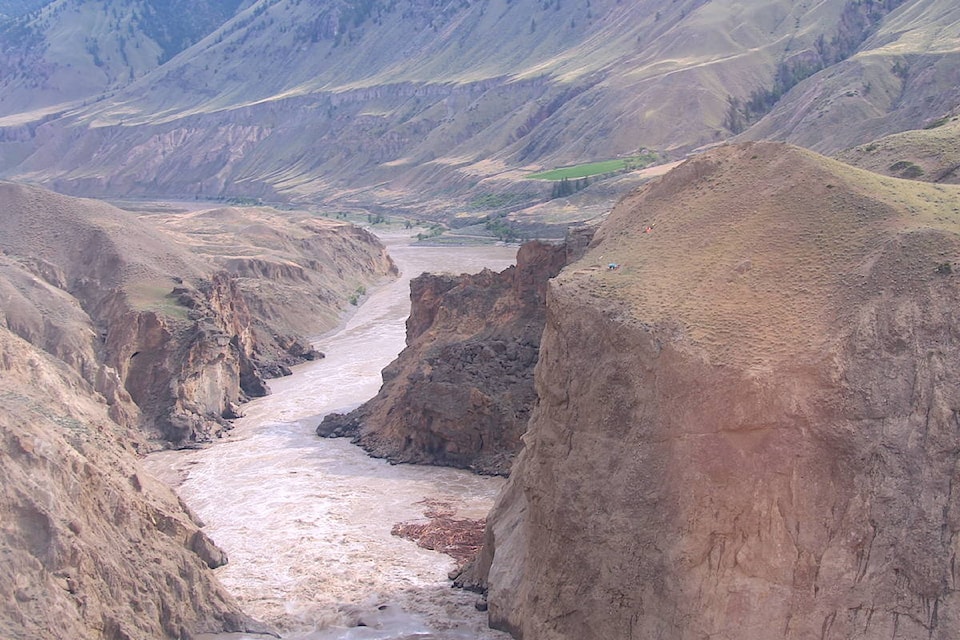Hotwash – evaluation of an agency’s performance following a disastrous event.
The DFO will hotwash efforts to rescue millions of Fraser River salmon prevented from migrating past a three-metre waterfall created by the Big Bar rock-slide this year.
“Its purpose,” says media officer Leri Davies, “is to identify lessons for future implementation.”
The Fraser is the world’s biggest producer of sockeye. Two-thirds spawn above the slide.
In July, as salmon backed up, an incident command team – DFO, the province, and First Nations – wrestled with three response options.
One – not as strange as it sounds – was “take no action, but monitor fish moving through.”
The incident team opted to move fish upstream with helicopters and trucks.
Moving fish ended Sept. 4 when Mother Nature interceded.
Lower water levels allowed them to swim up unaided.
Was moving fish successful?
“For its limited objectives,” says Davies. “The movement of fish above the slide was determined to be effective in assisting fish that had no other way to move upstream, to have a chance of continuing their migration.”
Some disagree.
“This is a public gimmick,” Tsilhquot’in FN Chief, Joe Alphonse (Chilcotin) told me. “The water dropped to let the fish pass, not the transporting above the slide.”
Don Willimont is with the Spruce City Wildlife Association’s hatchery near Prince George. In an Aug. 21 video, he said salmon hadn’t returned to local streams.
“We’re struggling to get a female and a male to the hatchery. They’ll be no run in five years. Most fish probably died.”
This month, the association met with key DFO staff for information.
“We said only three to five per cent of the fish transported survived. They told us it was three per cent. Obviously, the efforts decided weren’t the best ones.”
Davies wouldn’t deny percentages.
But, “Until I can get numbers from the project managers and scientists, I can’t say. However, we know some fish transported had been holding and exhausting themselves trying to get past the slide,” and “would have been challenged to make it to their natal stream and successfully spawn.”
Language can make things sound better than they are.
As salmon struggled, DFO updates heralded a “unique” incident team “immediately mustered” to develop an “emergency action plan,” and “considering multiple options.”
From mid-July, we got daily tallies of salmon “successfully” lifted.
“Whatever they say, the model didn’t work,” says Willimont. “The recovery story was all about three levels of government holding hands more than anything. They celebrated the number of fish moved, but nobody talked about the number that didn’t get there.”
No one talked about exploding the blockage, either. It was urged by Willimont, Alphonse, and retired DFO biologist Matt Foy. All say “the window of opportunity” is now February.
“The Canadian Armed Forces have been engaged,” Davies says, “but there’s significant risk an explosion could create a secondary slide event, exacerbating the existing problem. We’re gonna do it, we just don’t know how.”
Could mitigation have preceded the runs? Perhaps, with regular river monitoring.
When asked in August why aerial surveillance wasn’t standard practice, Fisheries Minister Jonathan Wilkinson replied: “We don’t necessarily go up and down the river every six months doing inspections.”
Yet, DFO has made 15 drone flights since June.
“It’s expected to be a component of long-term monitoring of the slide area,” says Davies, ”but we have no plans to mount such flights throughout the Fraser Canyon.”
On June 27, DFO reported 40,000 fish blocked. Yet the team still didn’t know what to do.
Rock scaling to make work below safer – a primary objective – didn’t start until mid-July. It stalled work below.
Tagging and counting fish was halted July 9 by the “influx of high water from flooding in the Chilcotin.”
On July 14, the team was “considering” a fish ladder, but only the “design and construction.”
And, on July 27, dip netting and even angling were used to capture salmon.
Eventually, seine nets – bigger catches – were employed, and helicopters with buckets. Yet, as of July 31, only 1,400 fish had been moved, with more “arriving every day.”
Being netted and bounced about is hard on fish. Many die.
On Aug. 10, a pescalator finally arrives. It’s a device to move fish more gently. Rocks are dropped to the river edge to form a “natural ladder.”
Updates are celebratory.
“This continues to be a successful strategy that enables salmon to bypass the obstruction.”
The ladder isn’t completed.
Taking no action would have put less stress on salmon, but that was unlikely before an election.
There was no good news for one, either.
The action plan at Big Bar involved hundreds of field workers, heavy equipment, rock scalers and road-building crews. Cost effective?
DFO hasn’t released those numbers either.
Slides happen along the Fraser. Will salmon survive the next one?
Only if “lessons learned” don’t mince words in a hotwash report.
Jack Emberly is a retired teacher, local author and environmentalist.
